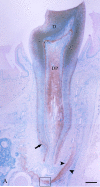Dentin sialophosphoprotein in biomineralization
- PMID: 20367116
- PMCID: PMC2933432
- DOI: 10.3109/03008200903329789
Dentin sialophosphoprotein in biomineralization
Abstract
Two of the proteins found in significant quantity in the extracellular matrix (ECM) of dentin are dentin phosphoprotein (DPP) and dentin sialoprotein (DSP). DPP, the most abundant of the noncollagenous proteins (NCPs) in dentin is an unusually polyanionic protein, containing a large number of aspartic acids (Asp) and phosphoserines (Pse) in the repeating sequences of (Asp-Pse)(n). and (Asp-Pse-Pse)(n). The many negatively charged regions of DPP are thought to promote mineralization by binding calcium and presenting it to collagen fibers at the mineralization front during the formation of dentin. This purported role of DPP is supported by a sizeable pool of in vitro mineralization data showing that DPP is an important initiator and modulator for the formation and growth of hydroxyapatite (HA) crystals. Quite differently, DSP is a glycoprotein, with little or no phosphate. DPP and DSP are the cleavage products of dentin sialophosphoprotein (DSPP). Human and mouse genetic studies have demonstrated that mutations in, or knockout of, the Dspp gene result in mineralization defects in dentin and/or bone. The discoveries in the past 40 years with regard to DPP, DSP, and DSPP have greatly enhanced our understanding of biomineralization and set a new stage for future studies. In this review, we summarize the important and new developments made in the past four decades regarding the structure and regulation of the Dspp gene, the biochemical characteristics of DSPP, DPP, and DSP as well as the cell/tissue localizations and functions of these molecules.
Figures








References
-
- MacDougall M, Simmons D, Luan X, Nydegger J, Feng J, Gu TT. Dentin phosphoprotein and dentin sialoprotein are cleavage products expressed from a single transcript coded by a gene on human chromosome 4. Dentin phosphoprotein DNA sequence determination. J Biol Chem. 1997;272:835–42. - PubMed
-
- Fisher LW, Torchia DA, Fohr B, Young MF, Fedarko NS. Flexible structures of SIBLING proteins, bone sialoprotein, and osteopontin. Biochem Biophys Res Commun. 2001;280:460–5. - PubMed
-
- Qin C, Brunn JC, Cadena E, Ridall A, Tsujigiwa H, Nagatsuka H, Nagai N, Butler WT. The expression of dentin sialophosphoprotein gene in bone. J Dent Res. 2002;81:392–4. - PubMed
-
- Baba O, Qin C, Brunn JC, Jones JE, Wygant JN, McIntyre BW, Butler WT. Detection of dentin sialoprotein in rat periodontium. Eur J Oral Sci. 2004;112:163–70. - PubMed
-
- Alvares K, Kanwar YS, Veis A. Expression and potential role of dentin phosphophoryn (DPP) in mouse embryonic tissues involved in epithelial-mesenchymal interactions and branching morphogenesis. Dev Dyn. 2006;235:2980–90. - PubMed
Publication types
MeSH terms
Substances
Grants and funding
LinkOut - more resources
Full Text Sources
Miscellaneous
